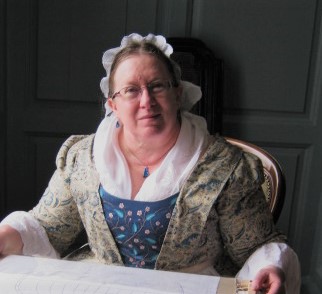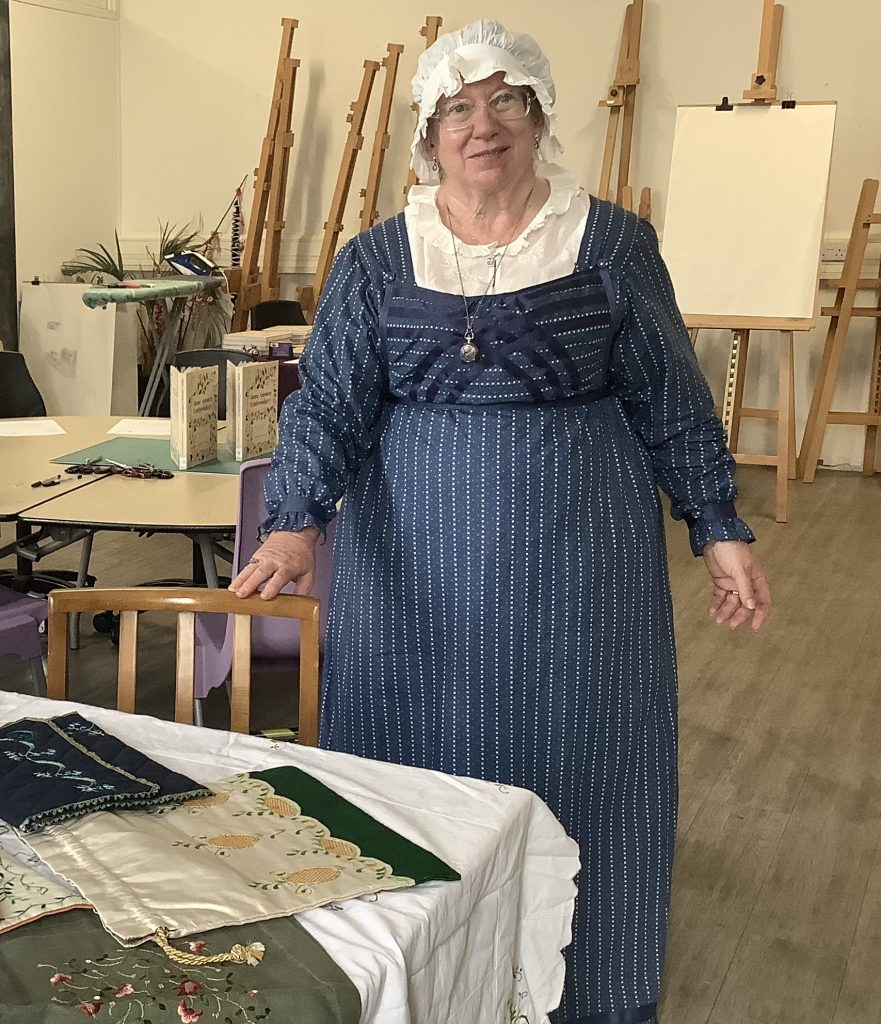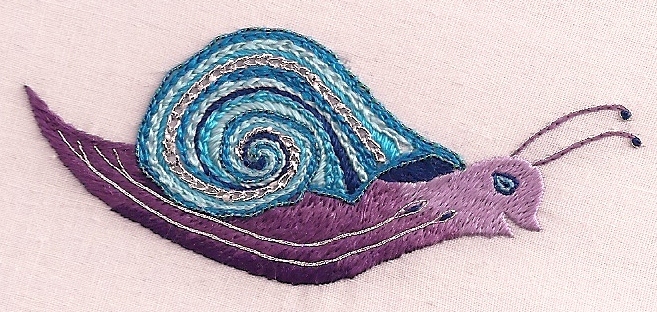I spent quite a lot of time during Covid Lockdown in 2020-21 working on making ‘dress-up’ costumes. This is a widespread hobby, which includes everything from costumes in museums for kids to try on, through to die-hard historical re-enactors such as Zack Pinsent, the period tailor who dresses in Georgian costume all the time. It was highlighted quite a lot during festivities for Jane Austen’s bicentenary in 2017, and again during series 6 of Great British Sewing Bee, by Clare Bradley the winner, who loves dressing in 1940s style.
I’m as guilty as anyone of dressing up. When I started working in embroidery full-time, my first project was to make a replica of a waistcoat originally stitched for Captain James Cook by his wife Elizabeth. This was a fabulous project to work on, because it really gave my work direction: I became fascinated by the embroidery of the Georgian period. I was particularly taken with the gorgeous embroidery on costume worn by both men and women during the period, but particularly by men. Their waistcoats and court frockcoats were incredibly beautifully decorated. Museum research for the Cook waistcoat showed me what lovely work had been done, and I wanted to reproduce it.
Part of my plans for my embroidery work was always to do lectures and demonstrations of period embroidery. Lecturing was my day job for 30 years, albeit in Biology, and I always enjoyed it. I also love demonstrating and talking about embroidery. It seemed a logical use of my skills. It also seemed logical that when I was talking about Georgian embroidery, I should dress-up in suitable costume, which meant further research and time spent making my own appropriate outfits. I did try and hire an outfit for an early event, before I had had time to make anything, and it was horrid! The style was wrong, the synthetic fabrics didn’t hang right, and the size was terrible. I’m not an easy size to fit, being somewhat ‘cuddly’, you might say – being blunt, I’m well overweight!
The only problem with making costumes for myself is – I’m a nerd! Although I was always a scientist/biologist as a youngster, I enjoy history as well. My mum was a maritime historian (which helped a lot with the Capt. Cook research!) and there was always a certain pressure towards accuracy. I wouldn’t go quite so far as getting specially woven fabrics or specially produced threads, but I am on a perennial hunt for modern materials which provide a good equivalent. Especially in terms of fabric and threads: I don’t like working with synthetic fabrics or polyester threads.
I also love hand-sewing. I have always preferred hand-work to machine, both in terms of dress-making and embroidery. Machine embroidery has always felt a little like cheating: although I have seen some beautiful machine embroideries over the years, and I have a lot of respect for folks who can design and work pieces in free-motion machine stitching, it just doesn’t appeal to me. It can be frustrating when you want to make something and you have to factor in the loooooonnnggg time needed for hand stitching, but I look at some of the ‘quick-fix’ stitching stuff you see for sale on things like Amazon and die a little inside.
So as a result of all this I have condemned myself to extensive hand-stitching, lots of cottons, linens and silks, and a perennial hunt for natural fabrics in shops and online. Plus quite a lot of time doing embroidery. None of this is too much of a chore, it should be said: it keeps me out of mischief! And it does go down well at events. It surprises visitors that I have stitched all my costumes myself, and by hand, but I wouldn’t think of doing anything else. I started off channelling Elizabeth Cook, so the costumes I made to start with were 1770s period: wide skirts and embroidered stomachers.

One aspect of HA (historical accuracy, if you haven’t got into re-enactment websites) is having to have the appropriate underpinnings for each outfit, which means making a costume is not just a matter of making a dress/gown. You also need underwear – shift, stays, petticoats, hoops. You can’t use real whalebone for boning any more, it’s illegal, thank the Lord, but synthetic whalebone works well. All hand-stitched, of course. I developed a case of corset-makers thumb while making my first set of stays. The problem is not pushing the needle through the fabric, which can be 4-5 layers of linen for a set of stays, it is PULLING the needle through, which needs a tight grip. My thumb ached after a good session. A friend helped a lot when she told me to use disposable gloves: they give you a much better grip on the needle.
So I started with several costumes based on 1770s style, which I used for lectures and demos. They vary from a formal ‘silk’ evening gown (actually it’s polyester: that’s what convinced me that having real silk was crucial!) to an informal jacket and quilted petticoat. The quilted petticoat took ages to make. I should have kept track of how much time it took, but didn’t. They are surprisingly comfortable to wear, even the stays. They give you a lot of back support, and I have worked in them all day without any real problems, except one. When it’s time for a lunch break, you need an upright chair: you can’t sit in a 20-21st century armchair in 1770s stays! Especially if you have as many geraniums on your balcony as I do: I get sandwich crumbs in my cleavage every time.
From about 2016 I was working on a book based on embroidery patterns published in The Lady’s Magazine, with Jennie Batchelor. It was published in March 2020 by Pavilion Books, (just before lockdown) and we called it Jane Austen Embroidery. This has led to a dilemma – or perhaps an excuse? If I am doing events themed around the book, people will expect Austen-style costumes. The later Georgian period was one of huge change in fashion styles, from the tight bodices and exaggerated skirts of the 1700s to the slim ‘empire-line’ style of the Regency. So I needed Regency costumes as well as 1770s ones, plus all the appropriate underpinnings and accessories. It became a great excuse for a whole new wardrobe!

I had a lovely time making day dresses of printed cotton, chemisettes of cotton voile, shifts of ramie (it makes a good substitute for fine linen, which is difficult to find today). I tried out a pattern for a Spencer from Cassidy Percoco, and found some lovely striped silk a few years ago which will make a fabulous evening gown. Finding or adapting patterns is a problem, given that I am definitely NOT average regency size, so I tend to go through a lot of cheap calico making toiles to check the patterns.
Lockdown did cause some issues: little exercise and quite a lot of morale-boosting cake! Fortunately corsets can do a lot of squeezing if necessary: I actually have a waist when I put them on, it’s really rather fun! However, just as lockdown eased off and events started happening again, life threw me another curveball in the form of health issues which required chemotherapy. As a result I lost a LOT of weight – and sadly put some of it on again afterwards. Actually a good thing really, as I had lost too much muscle mass.
So my Regency persona (and my mid-Georgian one) are both going to need some work. I have managed to adjust one Regency gown so it fits with some help from a dress-making pal, but the rest need taking in etc. With Jane Austen’s 250th birthday next year, I also need some new frocks, I fear! Can’t go to a fancy event in Bath in the anniversary year in a re-fitted gown: just won’t do, my dear! Sadly I’m far too old to be Lizzie Bennett, and I refuse to be Mrs Bennett, so I think I’m channelling Mrs Gardiner, Lizzie’s aunt. Here follows an Autumn and Winter of hand-sewing…..



Mrs Gardiner sounds the perfect one to channel!
A fascinating read, thank you.